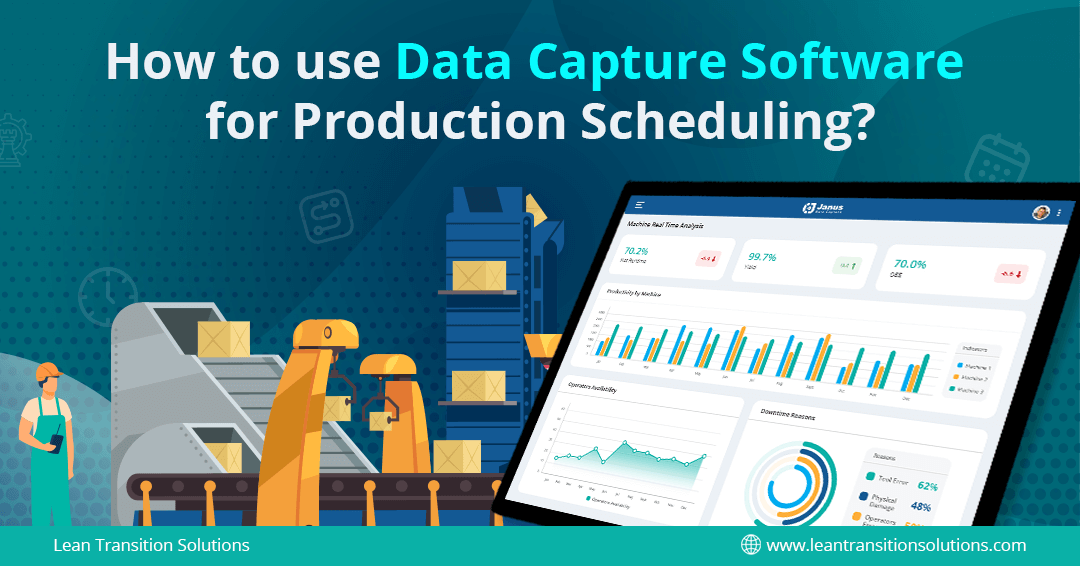How to use Data Capture Software for Production Scheduling?
July 2, 2024
Are you tired of the inefficiencies and headaches caused by relying on outdated spreadsheet-based production scheduling methods? Many manufacturers have already switched to data collection systems to manage their production schedules.
Imagine a system that automatically prioritises your manufacturing tasks, allocates materials to open orders, and generates a production plan without you lifting a finger. This isn't just a futuristic dream – it's a reality made possible by real-time data collection technologies. In this blog, we'll explore how you can harness the power of data-driven automation to streamline your production scheduling process, optimise resource utilisation, and stay ahead of the competition.
What is Production Scheduling in Manufacturing?
Manufacturing production scheduling refers to the systematic planning and organisation of manufacturing activities to optimise the use of resources and meet production goals efficiently. A production schedule requires creating a timetable or sequence for executing various tasks, such as production, inventory management, and resource allocation, to ensure that products are manufactured promptly and delivered to customers according to demand.
Effective production scheduling requires balancing factors such as production capacity, demand forecasting, inventory levels, lead times, and production costs to maximise productivity and minimise production delays or inefficiencies. By implementing robust production scheduling practices, manufacturers can optimise production processes, reduce lead times, improve on-time delivery performance, minimise inventory holding costs, and enhance overall operational efficiency.
Production scheduling techniques, utilising data collection approaches, are instrumental in production success. They optimise scheduling decisions and respond dynamically to changes in demand or resource availability, ensuring our competitiveness and ultimately leading to our overall success in various organisations.
Production scheduling can be categorised into three types:
Master Production Scheduling (MPS), which outlines the complete process from beginning to end.
Manufacturing or Operation Scheduling, which focuses on the routing of raw materials.
Retail Operation Scheduling, which ensures that finished products are delivered from the manufacturing facility to retail stores.
Why is Production Scheduling and Planning important?
Production scheduling and planning are not just important; they are the backbone of a business's success and competitiveness. They empower us to optimise our resources, meet customer expectations, and make strategic decisions. Production scheduling is not just a process; it's a key driver of our success, offering several benefits like :
Efficiency and Productivity: Effective scheduling and planning optimise the use of resources, minimising downtime and ensuring that production processes run smoothly. It drives higher productivity and more efficient operations.
Cost Reduction: By carefully planning and scheduling production activities, businesses can reduce waste, lower inventory costs, and decrease labour expenses. This helps manage budgets more effectively and improves profitability.
Meeting Deadlines: Proper scheduling ensures products are manufactured and delivered on time. It is vital for meeting customer expectations, maintaining satisfaction, and fostering long-term relationships.
Flexibility and Adaptability: Effective production planning allows businesses to respond quickly to customer demands, supply chain disruptions, or other unforeseen events. This flexibility helps maintain continuous operations and meet market demands.
Inventory Management: By synchronising production schedules with demand forecasts, businesses can maintain optimal inventory levels. This minimises the risk of overproduction or stockouts, ensuring a balanced supply chain.
Strategic Decision Making: Comprehensive production planning provides valuable data and insights, enabling better decision-making at strategic levels. It helps identify areas, forecasts, and plans for growth.
How can Data Capture Software help in Production Scheduling?
Data capture software is a technological solution designed to collect, process, and manage data from various sources within an organisation. Data collection software automates data gathering, often in real-time, from equipment, sensors, human inputs, and other data-generating systems. The captured data is used for analysis, decision-making, and process optimisation.
Real-Time Data Collection : Data capture software provides continuous, real-time insights into the production process by collecting data from machinery, sensors, production lines, and employee inputs. This immediate flow of information allows for timely adjustments to production schedules based on actual conditions, enhancing responsiveness and operational agility.
Accurate Forecasting : With its ability to accumulate and analyse historical data, data collection software is a reliable tool for generating more precise demand forecasts. This foresight allows for better planning and scheduling, ensuring that production is closely aligned with projected demand and minimising the risks of overproduction or stock shortages.
Enhanced Resource Management : The software tracks productivity and utilisation of resources such as raw materials, labour, and equipment. This detailed monitoring ensures that resources are optimally allocated and potential shortages or surpluses are quickly identified and addressed. This leads to more efficient resource use and prevents production delays.
Improved Efficiency : Data capture software helps optimise production scheduling by identifying inefficiencies in the production process, such as excessive cycle times, underutilised machinery, or workflow bottlenecks. These insights enable managers to refine schedules, streamline operations, and boost productivity.
Quality Control : Continuous monitoring of production parameters through data capture software ensures that quality standards are consistently met. Any deviations from the desired quality metrics trigger immediate alerts, allowing quick corrective actions. This proactive approach can maintain product quality and minimise the risk of defects.
Enhanced Communication and Coordination : Data capture software provides a centralised platform for sharing data across different departments, fostering better communication and coordination. This transparency ensures that all stakeholders, including production, logistics, and management, are informed about schedule changes and resource availability, leading to more cohesive and efficient operations.
Predictive Maintenance : The manufacturing scheduling software analyses machine data to predict maintenance needs, reducing unexpected downtime. Scheduled maintenance activities can be planned during non-peak hours, minimising disruptions to the production schedule and ensuring optimal equipment working conditions.
Compliance and Reporting : Data collection software helps maintain compliance with industry regulations with accurate records of production activities. This simplifies the reporting process and ensures all regulatory requirements are met without interfering with the production schedule.
- Customer Satisfaction : Reliable and timely production schedules enabled by data capture software ensure that delivery deadlines are consistently met. This reliability enhances customer satisfaction and strengthens the business’s reputation for dependability.
Optimising Production Scheduling using Data Capture Software
By following these six production scheduling steps and integrating data capture software into each production phase, businesses can optimise their manufacturing production scheduling, resulting in more efficient operations and improved outcomes.
Planning
Define the objectives and scope of the production process.
Data capture software is used to analyse historical data and forecast demand.
Develop a comprehensive production plan that aligns with business goals and resource availability.
Routing
Determine the most efficient paths for materials and components through the production process.
Utilise data capture software to map out the optimal routes based on real-time data and resource constraints.
Ensure that materials move smoothly from one stage to the next without bottlenecks.
Scheduling
Create detailed schedules for production activities, specifying start and end times for each task.
Leverage data capture software to adjust schedules dynamically based on real-time data and changing conditions.
Prioritises tasks to maximise efficiency and meet delivery deadlines.
Dispatching
Assign tasks to workers and machines according to the production schedule.
Use data capture software to track task assignments and ensure that all resources are utilised effectively.
Communicate schedules and assignments clearly to all team members.
Executing
Carry out the production activities as per the schedule.
Monitor progress in real-time using data capture software to ensure adherence to the plan.
Address any issues or deviations immediately to keep the production on track.
Maintaining
Continuously collect data on production performance and equipment condition.
Use data capture software for predictive maintenance to prevent unexpected downtime.
Regularly review and update production schedules based on the latest data and performance metrics.
Integrations in Data Collection Software for Production Schedule Management
Manufacturing Execution System (MES) : Integrating with MES provides real-time visibility into production activities, enabling seamless data exchange between production planning and execution systems.
Enterprise Resource Planning (ERP) : Integration with ERP systems allows for holistic management of production schedules, tying production data to broader business processes such as inventory management, procurement, and finance.
Supply Chain Management (SCM) : Connecting with SCM systems enables better coordination of production schedules with supplier deliveries and customer orders, optimising the entire supply chain.
Internet of Things (IoT) Devices : Integrating with IoT devices on machinery and equipment allows for the automatic collection of production data, facilitating real-time monitoring and analysis for proactive scheduling adjustments.
Quality Management Systems (QMS) : Integrating with QMS systems ensures that quality metrics are captured and analysed as part of the production scheduling process, helping to maintain product quality standards.
Warehouse Management Systems (WMS) : Integration with WMS systems provides visibility into inventory levels and locations, enabling better planning of production schedules based on available materials and storage capacity.
Customer Relationship Management (CRM) Software : Integrating with CRM systems allows for the alignment of production schedules with customer demands and preferences. By accessing customer data, businesses can prioritise orders, plan production accordingly, and ensure timely delivery to enhance customer satisfaction.
- Accounting Software : Integration with accounting software enables the synchronisation of production schedules with financial data and transactions. This integration streamlines processes such as cost tracking, invoicing, and budgeting, ensuring that production schedules are aligned with financial objectives and constraints.
5 Ways to Improve Production Scheduling for Manufacturing
Enhance your Forecasting Accuracy : Analyse historical data and market trends using production scheduling software systems to improve the precision of predicting production needs.
Document your Production Capacity : Maintain detailed records of your manufacturing capabilities, including equipment, workforce, and space in data collection systems to ensure accurate scheduling and resource allocation.
Standardise Processes and Timing : Establish consistent procedures and timelines for each step of production to streamline operations and minimise variability.
Implement Real-Time Monitoring : Use real-time production planning and scheduling software to monitor production activities, allowing immediate schedule adjustments and resources based on actual performance.
Assess your Risk Factors : Identify potential risks to production scheduling, such as supply chain disruptions or equipment failures, and develop contingency plans to mitigate their impact.
The significance of machine data collected from various systems and production phases resonates across industries. Whether it's automobiles, healthcare, pharma, or energy, the benefits of these data sources are undeniable and applicable to all.
Integrating a data collection software into various production phases and departments of a business gains deeper insights into their operational processes. This holistic view enables more informed decision-making, better resource allocation, and improved efficiency and productivity.
By embracing data-driven approaches to production scheduling, organisations can unlock new levels of production efficiency, effectiveness, and innovation across the board. As technology continues to evolve, those who seize the opportunity to harness the power of data will undoubtedly lead the way towards a prosperous future in their industrial domain.
Use Janus Data capture Software for managing your Production Schedules!
Unlock unparalleled efficiency in production scheduling with our Janus Data Capture Software! Seamlessly integrate data from various sources to streamline your production schedules, optimise resource allocation, and maximise productivity. The real-time monitoring and analysis capabilities of our software empower you and your team to make informed decisions and stay ahead of the industrial competition. Experience the benefits of precise forecasting, improved OEE ( Overall Equipment Effectiveness) and proactive risk management, all at your fingertips.
